When it comes to staining wood, the decision between Water-Based Stain vs. Oil-Based Stain can drastically affect the outcome of your project. The right choice impacts your project’s durability, appearance, ease of application, and clean-up. In this post, we’ll dive into the key differences between these two types of stains, including their pros, cons, and ideal uses. By the end, you’ll be able to confidently choose which stain suits your needs.
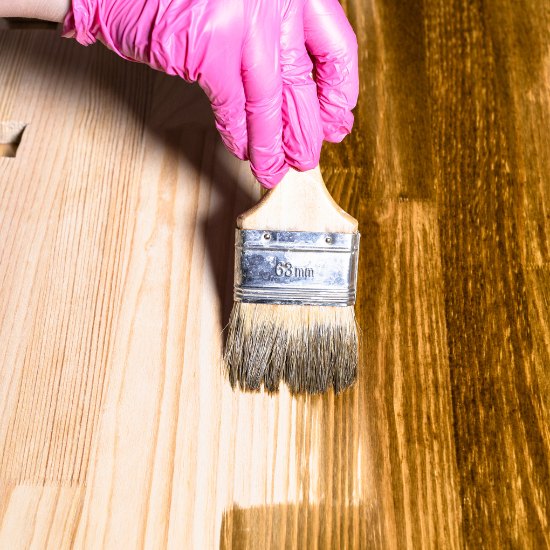
What is a Water-Based Stain?
A Water-Based Stain is made with water as its primary solvent. This means it is fast-drying, low-odor, and generally less toxic than oil-based options. Water-based stains penetrate the wood surface but don’t soak in as deeply as oil-based stains, making them a better option for certain finishes.
Benefits of Water-Based Stain:
✅ Faster Drying Time – Water-based stains dry much quicker than oil-based stains, often within 1-2 hours. This allows you to complete projects more efficiently, especially if you’re working with multiple coats.
✅ Low Odor & Low VOCs – Water-based stains have minimal fumes, making them a great choice for indoor projects, especially in spaces with limited ventilation.
✅ Easy Cleanup – Simply use soap and water to clean your brushes and any accidental spills, making this an ideal option for beginner DIYers.
✅ Color Retention – Water-based stains tend to resist fading over time and maintain their vibrancy longer than oil-based stains, making them a good choice for pieces that will see everyday use or be exposed to sunlight.
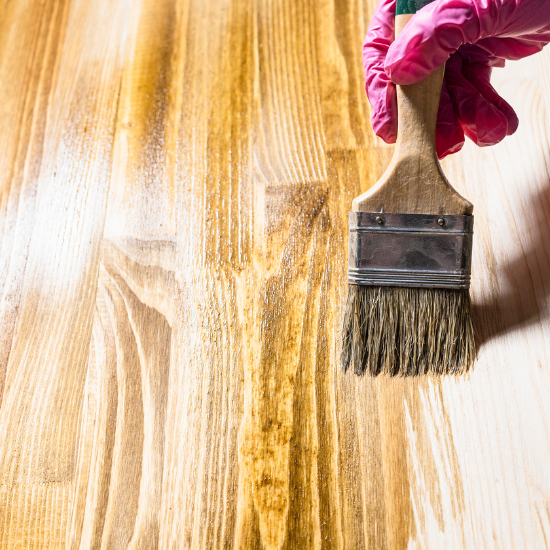
Best Uses for Water-Based Stain:
✔️ Indoor Projects – For furniture, trim, cabinets, or doors.
✔️ Light Woods – Works best on lighter woods like pine or maple, where you want a more vibrant, uniform color.
✔️ Fast Turnaround – If you’re working on a project with a tight timeline and need the stain to dry quickly between coats.
✔️ DIYers Who Want Low Maintenance – Since it cleans up with soap and water, it’s perfect for people who want a simple, hassle-free process.
What is an Oil-Based Stain?
An Oil-Based Stain uses oils (often linseed oil or tung oil) as its primary base. This type of stain has excellent penetration properties, soaking deeply into the wood grain to provide a rich, long-lasting finish that enhances the natural beauty of the wood.
Benefits of Oil-Based Stain:
✅ Deep Penetration – Oil-based stains soak into the wood grain, making them ideal for dense hardwoods like oak, walnut, and mahogany. The deep penetration highlights the wood’s natural texture and character.
✅ Longer Working Time – Oil-based stains have a slower drying time, giving you more time to adjust, blend, and work with the stain before it sets.
✅ Durability – Oil-based stains are typically more durable, resisting moisture, wear, and the effects of time. They are better for high-traffic areas and exterior applications.
✅ Rich, Warm Finish – The result is a warm, classic finish with deep hues that create a timeless look. Oil-based stains also enhance the wood’s natural grain and texture more vividly.
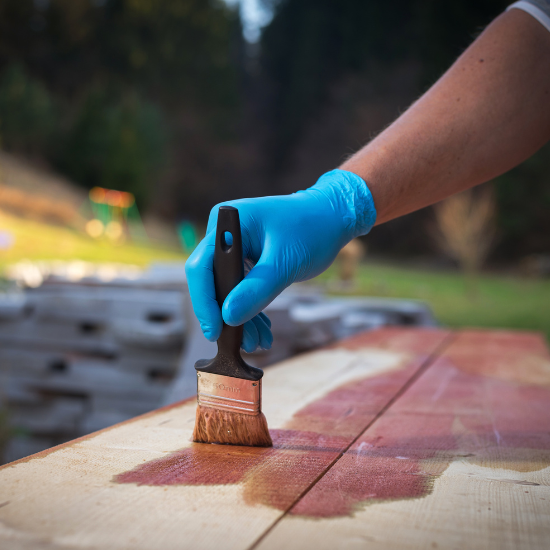
Best Uses for Oil-Based Stain:
✔️ Outdoor Projects – Oil-based stains are great for decks, fences, and outdoor furniture, where they need to withstand the elements.
✔️ High-Traffic Areas – Use on floors, stair treads, and any surface that will face constant wear and tear.
✔️ Hardwoods with Dense Grains – Works particularly well on hardwoods like mahogany, oak, and cherry, where you want the grain to pop.
✔️ Deep, Natural Look – If you desire a richer, more intense color with greater depth, oil-based stains provide that classic finish.
Water-Based Stain vs. Oil-Based: Key Differences
| Feature | Water-Based Stain | Oil-Based Stain |
|---|---|---|
| Drying Time | Quick, 1-2 hours for fast project turnaround | Slow, can take hours or a full day to dry |
| Odor | Low odor, ideal for indoor use | Strong odor, requires ventilation |
| Clean-Up | Soap and water | Requires solvents like mineral spirits |
| VOC Levels | Low, environmentally friendly | High, can have harmful fumes |
| Color Retention | Resists fading and maintains vibrancy over time | May fade over time, especially with sun exposure |
| Penetration | Less deep, best for lighter woods | Deep penetration, ideal for dense woods |
| Durability | Best for indoor use, may require more frequent re-coating | More durable, great for high-traffic or outdoor areas |
| Finish | Clean, uniform color | Rich, warm, and enhanced grain |
Which One Should You Choose?
Choosing between Water-Based Stain vs. Oil-Based ultimately depends on your specific project needs. Here are some key takeaways:
-
Choose Water-Based Stain If:
- You need quick drying times and minimal odor.
- You’re working with lighter woods and need vibrant color.
- You want a low-maintenance application process that’s easy to clean up.
- Your project is indoor and you want a more eco-friendly option.
-
Choose Oil-Based Stain If:
- You need deep penetration and enhanced wood grain visibility.
- You’re working with dense hardwoods or high-traffic areas.
- You desire a rich, long-lasting finish that can withstand the elements.
- Your project is outdoor or exposed to moisture.
You can shop some of my favorite stains HERE.
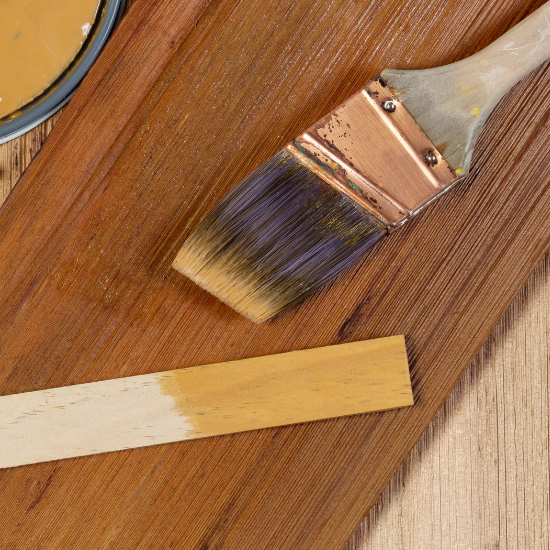
Final Thoughts: Water-Based Stain vs. Oil-Based
By now, you should feel confident about choosing between Water-Based Stain vs. Oil-Based. Whether you’re working on indoor furniture, outdoor decks, or any DIY wood project, understanding the strengths and weaknesses of each stain will help you get the results you want.
If you’re still unsure, consider your project’s timeline, location (indoor vs. outdoor), and the type of wood you’re working with. With this information in hand, you’ll be able to select the perfect stain for your next project.
I shared a full video review of my favorite gel stain so you could get a better look at what the colors actually look like. You can find that video HERE. Make sure to SUBSCRIBE when you are on my channel. I am launching new videos every week!
{Affiliate links are used in this post. Click on any underlined links to find the products and sources I am referring to. You can read my disclosure HERE.}
PIN THIS POST!
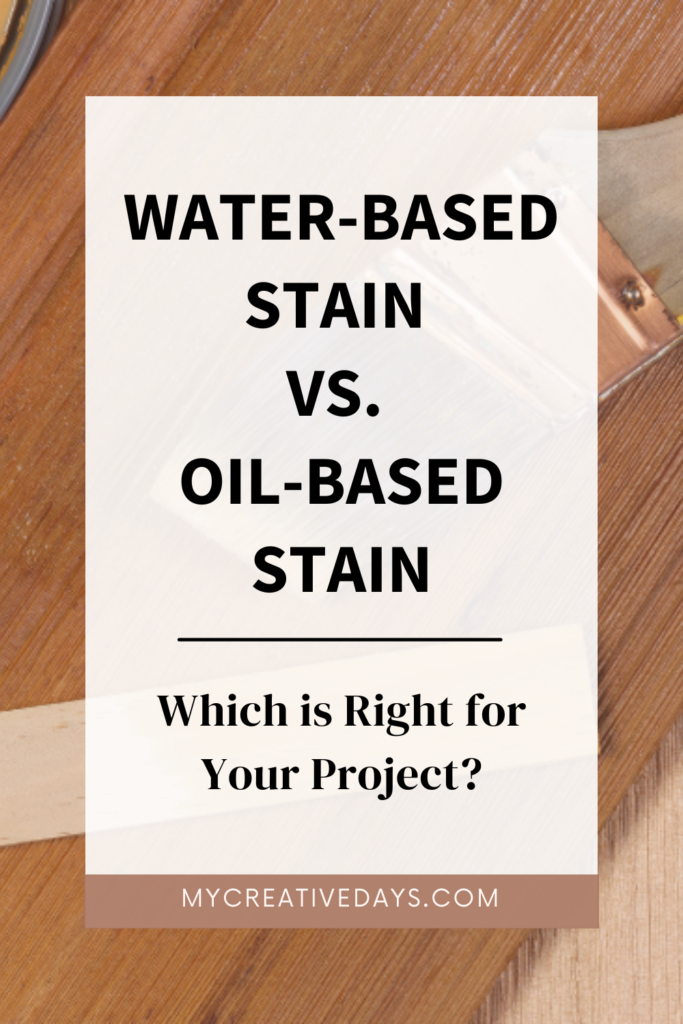
If you found this Water-Based Stain vs. Oil-Based post helpful, you will also like these:
Beginner’s Guide to Staining Wood Like a Pro
Painted And Stained Dresser Makeover
Differences Between Gel Stain and Regular Stain

